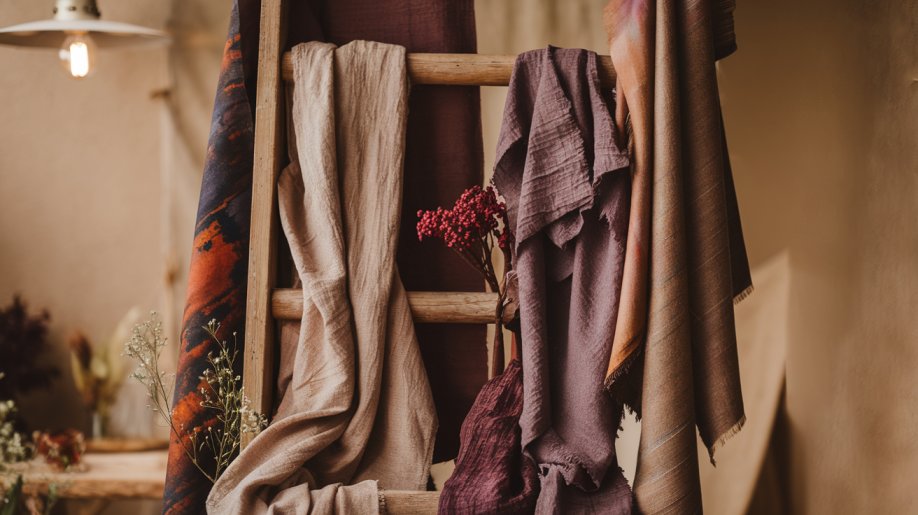Natural Dyed Fabrics, A Sustainable Choice
Imagine walking into a garden blooming with colors like vivid reds, deep indigos, and golden yellows. Now, picture those colors not as flowers but as the pigments adorning the fabric of your favorite dress, scarf, or shirt. Intriguing, right? Welcome to the vibrant world of natural dyes, where sustainability meets artistry; every hue has a story rooted in nature’s palette.
As fast fashion churns out synthetic materials at a breakneck speed, it’s time we turn to the ancient, eco-friendly art of natural dyeing, a practice that dates back thousands of years. However, natural dyes are not just about sustainability; they are about weaving culture, history, and a connection to the Earth into every thread of fabric.
So, Let’s start with this kaleidoscopic journey of organic hues, exploring how artisans craft these natural colors and how they transform not just fabrics but the fashion world itself.
The Magic of Natural Colors
Plants, minerals, and even insects derive natural dyes. Each source is a treasure trove of pigments waiting to be unlocked. Here’s how some of the most enchanting organic colors come to life:
1. The Royal Indigo
The green leaves of the indigo plant produce a deep blue hue that people have prized for centuries. The process begins by fermenting the leaves in water to release indican, a precursor to indigo. The liquid transforms into the iconic blue dye through oxidation and careful manipulation. Fabrics are immersed repeatedly in this magical potion, each dip darkening the shade.
Fun Fact: Fabric looks green when wet but turns blue as it reacts with air!
2. The Radiant Reds
Cochineal insects are the secret behind one of the most vibrant natural reds. These tiny bugs are dried, crushed, and treated with an acidic solution to extract carminic acid, the source of crimson. Alternatively, madder root offers a more earthy red, achieved by boiling the roots and infusing the fabric with its rich pigment.
3. The Sunshine Yellow
Turmeric, marigold flowers, and pomegranate peels are nature’s gift for creating radiant yellows. Turmeric, in particular, produces a stunning golden-yellow hue. Fabrics are boiled with the dye material and mordants (more on that later), locking in the color and ensuring its longevity.
4. The Verdant Greens
Unlike other colors, green often comes from layering dyes, typically indigo, with yellows from plants like weld or marigold. This process requires patience; you must carefully add each layer to create the perfect shade.
5. The Earthy Browns and Blacks
Walnut husks, acorns, and chestnut shells are natural sources of brown dyes. For black, tannin-rich materials like oak galls are paired with iron salts to achieve deep, dramatic tones.
Why Natural Dyes Matter?
The natural dyes for fabrics matter a lot as they provide comfort and sustainability:
- Eco-Friendly and Biodegradable: Synthetic dyes contain harmful chemicals, whereas natural dyes are biodegradable and non-toxic. They leave no harmful residue, protecting water bodies and ecosystems.
- Heritage of Craftsmanship: Natural dyeing is more than a process; it’s an art form passed down through generations. Supporting this craft preserves cultural heritage and empowers artisan communities worldwide.
- Skin-Friendly and Hypoallergenic: Because they lack harsh chemicals, fabrics dyed with natural pigments are gentle on the skin, making them ideal for people with allergies or sensitivities.
- Unique and Irreplaceable: No two naturally dyed fabrics are exactly alike. The variation in shades and tones adds a unique, one-of-a-kind charm to every piece.
The Challenges and The Path Forward
While the beauty and benefits of natural dyes are undeniable, there are challenges. The process is labor-intensive, requires significant water usage, and the colors may fade faster than synthetic dyes. However, advancements in eco-dyeing techniques and collaborations between artisans and sustainable fashion brands pave the way for greater efficiency and longevity.
The Colors of Nature
Natural dyes are a sustainable choice; the vibrant hues they produce celebrate Earth’s beauty. Each color carries a story, and each fabric is a testament to the creativity and care of the artisans who crafted it. By choosing naturally dyed fabrics, you are not just making an eco-conscious decision but embracing a timeless tradition that connects us to nature most beautifully and colorfully.
So, the next time you wrap yourself in an indigo scarf or slip on a turmeric-dyed shirt, take a moment to appreciate what you’re wearing. You are not just donning a piece of fabric; you are wearing a piece of history, artistry, and sustainability. It is time we let the colors of nature shape the future of fashion.


